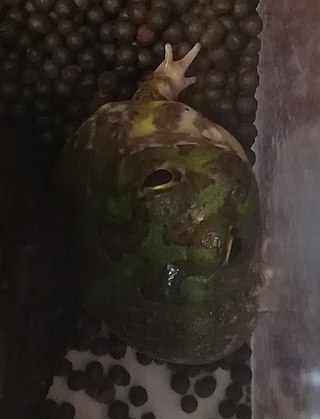
Corroboree frogs comprise two species of frog native to the Southern Tablelands of Australia. Both species are small, poisonous ground-dwelling frogs. The two species are the southern corroboree frog and the northern corroboree frog. They are unique among frogs in that they produce their own poison rather than obtain it from their food source as is the case in every other poisonous frog species.

Atelopus franciscus, the Central Coast stubfoot toad, is a species of toad in the family Bufonidae, endemic to the central coastal region of French Guiana. It is a locally common, diurnal species found near fast-flowing small streams and creeks in lowland rainforest. Many authors have suggested this taxon might be a synonym of Atelopus flavescens. It is threatened by habitat loss.

Nymphargus grandisonae is a species of frog in the family Centrolenidae. It is found in Andes of Colombia and Ecuador. Its natural habitat is tropical moist montane forest ; larvae develop in streams and still-water pools. Its habitat is threatened by habitat loss, introduced fish, and agricultural pollution, but it is still a common species not considered threatened by the IUCN.

Hyalinobatrachium pellucidum, also known as the Rio Azuela glass frog, is a species of frog in the family Centrolenidae. It is found in lower montane rainforests on the Amazonian Andean slopes in Ecuador and Peru. The specific name pellucidum is Latin for "transparent" and refers to the transparent parietal peritoneum of this species.

The powdered glass frog or Chiriqui glass frog is a frog species in the glass frog family (Centrolenidae). The species is found from north-central Honduras south to northwestern Ecuador.

Chacophrys pierottii, the Chaco horned frog or lesser Chini frog, is a species of frog in the family Ceratophryidae. It is monotypic within the genus Chacophrys. It is found in the Chaco of northern Argentina, eastern Bolivia, and western Paraguay. Its natural habitats are dry shrubland and gallery forest. Outside the breeding season adults remain buried underground but emerge during the first heavy rains to breed in temporary ponds.

Pristimantis acuminatus is a species of frog in the family Strabomantidae. It is found in the Amazon rainforest of Ecuador, northern Peru, and adjacent Colombia and Brazil. It is a lowland Amazonian rainforest species that also occurs on the lower reaches of the Andes. At night these frogs can be found perched on leaves some 10–15 m (33–49 ft) above the ground; during the daytime they may be found in bromeliads or sleeping on the undersides of leaves. It may also occur in cultivated areas. This widespread species is not considered threatened.
Pristimantis infraguttatus is a species of frog in the family Strabomantidae. Endemic to Peru, it has been discovered in only two localities in the Rioja Province of San Martín Region; it occurs in the Alto Mayo Protection Forest. All known individuals were found on leaves on low vegetation less than a meter above the ground in humid forest at night. Reproduction is by direct development. It is threatened by habitat loss.
Serranobatrachus megalops is a species of frog in the family Strabomantidae. Its common name is San Lorenzo robber frog. It is endemic to the northwestern slopes of Sierra Nevada de Santa Marta, northern Colombia. It occurs in cloud forest areas where it is found in closed-canopy secondary forests, riparian forests, and pine plantations. It is a very common, terrestrial frog that can be found on fallen leaves and under rocks and logs. It is threatened by habitat loss.
Scythrophrys is a genus of frogs in the family Leptodactylidae. It is monotypic, being represented by the single species, Scythrophrys sawayae, commonly known as the Banhado frog, after its type locality. It is endemic to Serra do Mar in Paraná and Santa Catarina states, south-eastern Brazil. Its natural habitats are secondary and old growth forests; reproduction takes place in temporary pools. Its populations are scattered but it is locally common. It is threatened by habitat loss. This species was first described in 1953 by the American herpetologist Doris Mable Cochran whose research was focused on the herpetofauna of the West Indies and South America.
Otophryne robusta is a species of frog in the family Microhylidae. It is found in Guyana, Venezuela, and possibly Brazil. Its natural habitats are tropical moist montane forests and rivers. It is threatened by habitat loss.
Otophryne steyermarki is a species of frog in the family Microhylidae. It is found in western Guyana and in the Bolívar state in eastern Venezuela.
Amolops kaulbacki is a species of frog in the family Ranidae that is found in northern Myanmar and Mizoram in northeastern India. It is named after Ronald Kaulback, a British botanist and explorer who collected the type series. Very little is known about this species.
Nanorana yunnanensis, commonly known as Yunnan paa frog, Yunnan spiny frog, Bourret's paa frog or Bourret's frog, is a species of frog in the family Dicroglossidae. It is found in southwestern China, Vietnam, Myanmar, northern Thailand, and likely in the intervening Laos. Its natural habitats are small and large streams in montane forests, scrub vegetation and grasslands, and it has also been found in ditches. It is threatened primarily by collection for human consumption, but also by habitat loss caused by agricultural development and infrastructure development.
Odorrana andersonii is a species of frog in the family Ranidae.
Odorrana margaretae is a species of frog in the family Ranidae. It is found in southern and central China and northern Vietnam.
Gracixalus gracilipes, commonly known as the Chapa bubble-nest frog, black eye-lidded small tree frog, yellow and black-spotted tree frog or slender-legged bush frog, is a species of shrub frog from northern Vietnam, southern China, and northwestern Thailand.
Bachia pyburni is a species of lizard in the family Gymnophthalmidae. The species is native to northern South America.
Synapturanus zombie is a South American species of frog in the family Microhylidae.








